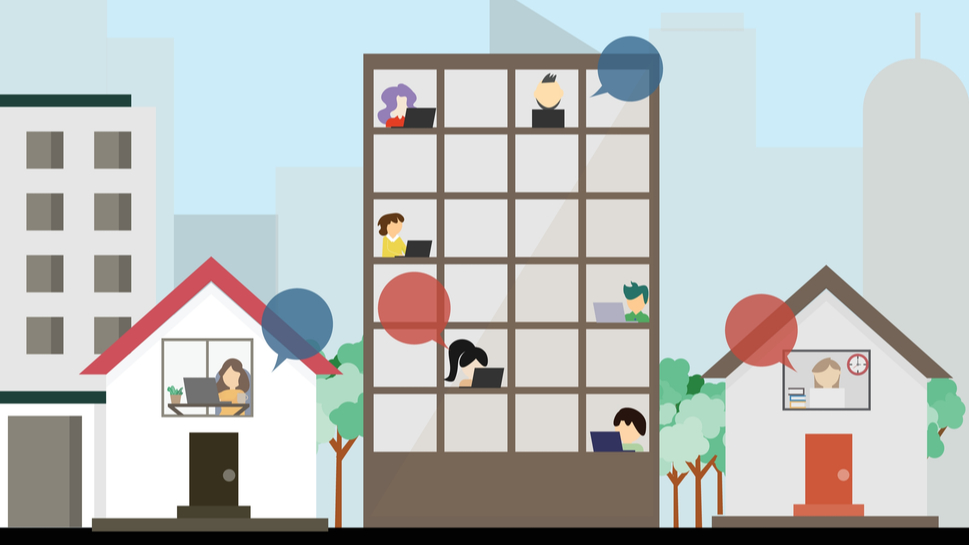The office as you know it is ancient history - the workforce has ‘moved on’
Hybrid working is the obvious solution, but there are challenges ahead

The rise of hybrid working is set to create serious new challenges for businesses, but the days of nine-to-five office work are firmly in the past, new research suggests.
According to a report from AV hardware company Poly, based on a survey of roughly 7,000 hybrid workers, 82% of people intend to spend at least one day a week working from home in future, while more than half (54%) will aim for an even split between the home and office.
Since the start of the pandemic, more than two thirds of people have also begun working atypical hours, instead of the traditional nine-to-five. Although “anytime working” has itself given rise to problems relating to culture, this new level of flexibility and autonomy has nonetheless become a main priority for the workforce.
- Here's our list of the best productivity software right now
- Check out our list of the best office software around
- We've built a list of the best collaboration tools on the market
The combination of hybrid and flexible working has left businesses with a number of questions to answer, says Poly, and companies cannot afford to revert to old habits as the world emerges from the pandemic.
“I was the CEO who thought people should all be in the office, and there are times I’m frustrated with the lack of interaction,” explained Dave Shull, Poly CEO. “But it is crystal clear from the research that the workforce has moved on. And CEOs that want to return to the nine-to-five are pushing against a tsunami.”
Whatever floats your boat
To mark the launch of the research paper, Poly hosted a panel session on the evolution of the workplace, attended by TechRadar Pro. The panel was made up of author Nicola Gillen, Microsoft’s Jenni Rantakari and executives from Poly.
The consensus among the speakers was that hybrid working is the only sensible option for businesses that want to retain talent in the post-pandemic marketplace. The workforce, they say, has a new set of demands.
Are you a pro? Subscribe to our newsletter
Sign up to the TechRadar Pro newsletter to get all the top news, opinion, features and guidance your business needs to succeed!
As highlighted by the research, there are a number of downsides to full-time remote working, especially for younger workers. The respondents highlighted an inability to switch off from work, missed learning opportunities and a lack of social interaction, among other challenges.
Equally, however, employees are also concerned about the return to the office; respondents cited the lengthy and costly commute, difficulty achieving work-life balance and a dip in productivity caused by noise and other distractions in the office.

Rantakari, who heads up Modern Work Solutions at Microsoft, says that hybrid working is the only viable solution given the range of factors at play, as well as disparities in the preferences and priorities of different demographics. But she believes managers will need to play a major role in stitching teams together and keeping employees connected.
“Hybrid working has put good management practices in stark relief,” added Paul Clark, VP EMEA Sales at Poly. “Managers have to be conscious that not everyone is the same; it’s about setting up a culture that supports people’s development.”
“There will be a fight for talent. Employees have tasted happiness now, and businesses need to think about how they can allow them to continue to taste that happiness after the pandemic.”
Challenges ahead
Although the panellists were universally in support of hybrid working, they did concede that businesses will face fundamental new challenges relating to logistics, infrastructure, culture and collaboration.
For example, it is easier to manufacture equitable meeting experiences when everyone is working from home, with each team member assigned their own video conferencing tile of equal size. However, when half of meeting attendees are in the office and half remote, equitable collaboration becomes much more challenging, because there are two playing fields to administrate.
Further, although a hybrid model can facilitate face-to-face interaction without compromising on the benefits of remote working, establishing the correct balance is likely to be easier said than done. Many businesses are bound to encounter a measure of friction in the next few months, as a result of this process of trial and error.
However, despite the challenges, Gillen claims that businesses cannot afford to look upon remote and hybrid working as a passing storm to be weathered.
“The pandemic hasn’t actually created a new trend, it has catalyzed something that has been playing out slowly over decades,” she said. “The days of people trooping in and out of major cities, expending all that money and carbon in order to sit in rows are long gone.”
Precisely what the workplace of the future will look like, though, nobody can quite say. Instead of diving in head first, Gillen proposes that businesses adopt an “experimental” approach to cultural change, at least in the short term.
“Previously, we have always had decades of research to support our strategies, but not in this scenario. The next few months will tell us a lot about what works and what doesn’t; businesses will need to try things out, test the boundaries and see what sticks.”
- Here's our list of the best project management software

Joel Khalili is the News and Features Editor at TechRadar Pro, covering cybersecurity, data privacy, cloud, AI, blockchain, internet infrastructure, 5G, data storage and computing. He's responsible for curating our news content, as well as commissioning and producing features on the technologies that are transforming the way the world does business.